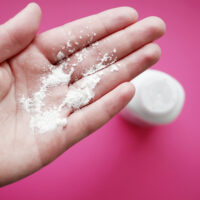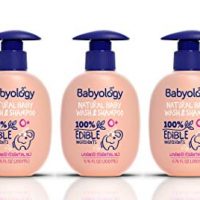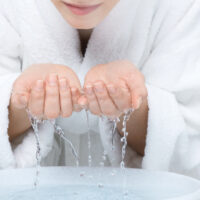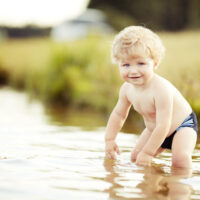Baby oil is one of those products that are great to have on hand for your little one. In addition to being great for locking in moisture and giving baby massage, baby oil has other uses you may not have even thought of. Below, you’ll find our top tips on how to use baby oil and answers to some FAQs about baby oil.
Benefits of Baby Oil
According to a study published in the IJCS (International Journal of Cosmetic Science), baby oil is typically used as a skin treatment. However, it is also used sometimes to relieve inflammation caused by diaper rash, to treat eczema without the use of steroids, and may even be used in small amounts (around 2-3 drops) to clean the ears. Below, we’ll take a look at these uses, as well as some other methods on how to use baby oil. (You can also learn more about our top picks for best baby oil for babies here).
Before we jump into this, you should note that baby oil should not be used on babies until they are at least one month old. Baby skin is working hard to create its own natural barrier in the first month. You may need to wait even longer if your baby was premature.
Baby Massage
Baby oil is among the preferred oils for baby massage. Baby massage is a great way for parents to bond with their children. It’s also incredibly relaxing, so it can even be used as part of a bedtime routine once your baby is old enough. (You should note that babies might be overstimulated by too much touch like a formal massage when they are too young).
Massage Prep
Baby massage works best when your baby is happy, but alert. Lay down a towel and place your baby in front of you, on the floor, a bed, the sofa, or somewhere else you will both be comfortable. Choose somewhere without overhead lights, but with enough light that your baby can see you. The room should also be warm.
You can leave your baby’s diaper on or off. If you don’t remove it, loosen the top of the diaper so you can better massage your baby’s tummy when it’s time.
Massage Techniques
Before you massage your baby, place some baby oil in your hands and rub them together to warm it up. Next, use slow, flowing strokes as you massage your baby. Start by holding your baby’s ankle with your hand. Use your other hand and stroke it from the top of the thigh down toward the ankle. Switch hands and repeat.
Next, focus on your baby’s feet. Stroke from heel to toe using your thumb and switch sides. After focusing on the feet, repeat the stroking motion on your child’s leg but go ankle to thigh instead. You can also do baby massage on your child’s arms or belly.
Note that this is the only example of how you might do baby massage. Pay attention to your child’s reactions and what they like/dislike. If they seem uncomfortable, they may not enjoy the stimulation or it might be a bad time. Baby massage is supposed to be a pleasant process- so stop if your child shows discomfort.
Moisturization
The best time to apply baby oil for moisturization is right after your baby’s bath. Since baby oil doesn’t moisturize the skin on its own, you want the skin to be slightly damp still when it is applied. Applying while wet locks in more moisture than applying baby lotion to dry skin.
Skin Inflammation and Diaper Rash
Like other petroleum-based products, baby oil can be useful in defending against diaper rash. Baby oil is an emollient. This means that it softens the skin to decrease dryness and flaking. It also creates a breathable layer that lets skin breathe to heal but protects it from extra moisture buildup. As an added benefit, baby oil is free of harsh ingredients, dyes, and perfumes that might irritate inflammation.
You can use baby oil like you would other diaper rash creams. Apply a thin layer each time you change your baby’s diaper. You’ll need to wipe away any excess as well- too much buildup creates skin irritation and may even cause folliculitis.
Something to note is that you should not apply baby oil to broken skin. You should also consult with your pediatrician if your baby’s rash has lasted longer than seven days.
Cleaning Your Toddler’s Ears
Baby oil helps break down earwax, making it easier to gently remove. For children who have an extreme buildup of earwax, it can make their ears easier to clean.
Baby oil is gentle enough that it can be used weekly to clean out ears. Put 2-3 drops in your child’s ear. Then, use a warm, wet washcloth to wipe away excess oil and the ear wax.
Something to note is that you shouldn’t use mineral oil drops in an infant unless instructed to do so by your doctor. You also shouldn’t use baby oil if your child has an ear infection.
Cradle Cap
Some babies experience cradle cap, which is similar to seborrheic dermatitis (the condition that causes dandruff) in adults. It’s most common before your baby is three months old, but some babies deal with it up until their first birthday or longer. Cradle cap causes thick, flaky skin on your little one’s scalp. Babies may also experience it behind the ears, on the nose, under the eyebrows, and even in the groin area.
One of the ways to treat cradle cap is providing moisture to the skin. Put mineral oil on your baby’s scalp (or other affected areas) and rub it in for about a minute. If your baby still has a soft spot, you’ll want to be very gentle around this area. Let the oil soak and wash it out about 15 minutes later. Something to note is that baby oil is very slippery- so be careful while your little one is in the tub.
FAQs – How to Use Baby Oil
Does baby oil clog pores?
No, baby oil designed for cosmetic processes will not clog your pores. Baby oil has a low level of comedogenicity, which means it isn’t likely to clog pores. It was tested against several other types of oil in this study.
However, something to note is that baby oil does work as a barrier to lock in moisture. This also means that it locks in anything on the surface of the skin, including dirt, oil, and other things that may clog the pores. You should be sure you are applying baby oil to clean skin to prevent acne from happening.
How does baby oil work?
Baby oil works by creating a barrier on the skin. It works best when the skin is damp because it also locks in any moisture already on the skin by stopping the natural process of evaporation. In this way, it makes moisture more readily available for the skin. While a barrier is created, it’s worth noting that it is semi-breathable, so it doesn’t stop the skin from breathing. You should also note that baby oil isn’t moisturizing on its own.
What is baby oil made of? Is baby oil safe?
Baby oil is derived from crude oil that has been processed, refined, and purified until all the harmful elements are removed and it is safe for the skin. Most baby oils use mineral oil as the base of their products. The result is a product that creates a barrier on the skin, locking in moisture.
Baby oil is very safe to use. The several steps of the process remove any harmful components, including polycyclic aromatic hydrocarbons. These are believed to be the component that causes cancer with mineral oil used in rats, which is identified by this study.
Additionally, baby oil designed for pharmaceutical or beauty applications is very unlikely to reach the percutaneous level of the skin and be absorbed into the body. Instead, most baby oil is absorbed by the stratum corneum. Its also unlikely to cause an allergic reaction in most people, because most formulations are free of phthalates, parabens, dyes, and fragrances unless the manufacturer adds them.
Final Word
Baby oil is a great choice for your little one’s delicate skin. In addition to locking in moisture, it can be used for cleaning ears, treating cradle cap, and more. Hopefully, this article has given you some ideas of how to use baby oil for your little one.






